Best Kitesurfing Spots in Switzerland
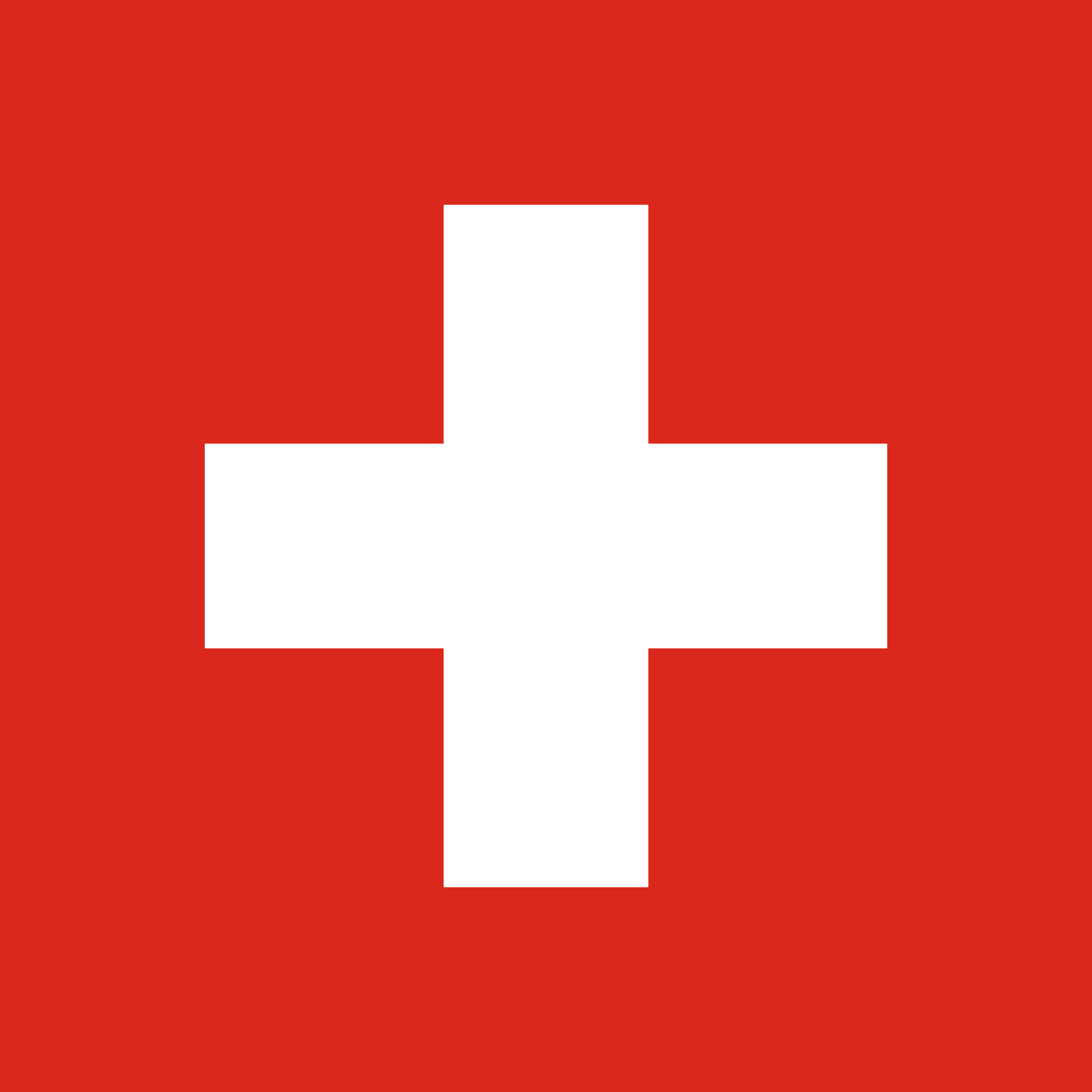
Switzerland, known for its majestic Alps and pristine lakes, offers a unique kitesurfing experience that beckons enthusiasts to explore its diverse waters. From the renowned Lake Silvaplana to the tranquil shores of Lake Neuchâtel, Switzerland’s kitesurfing spots provide a blend of natural beauty and ideal wind conditions.
But what sets these locations apart and makes them the top choices for kitesurfers seeking adventure and challenge? Let’s uncover the secrets behind Switzerland’s best kitesurfing spots and discover why they are a must-visit for anyone looking to harness the power of the wind in this stunning European destination.
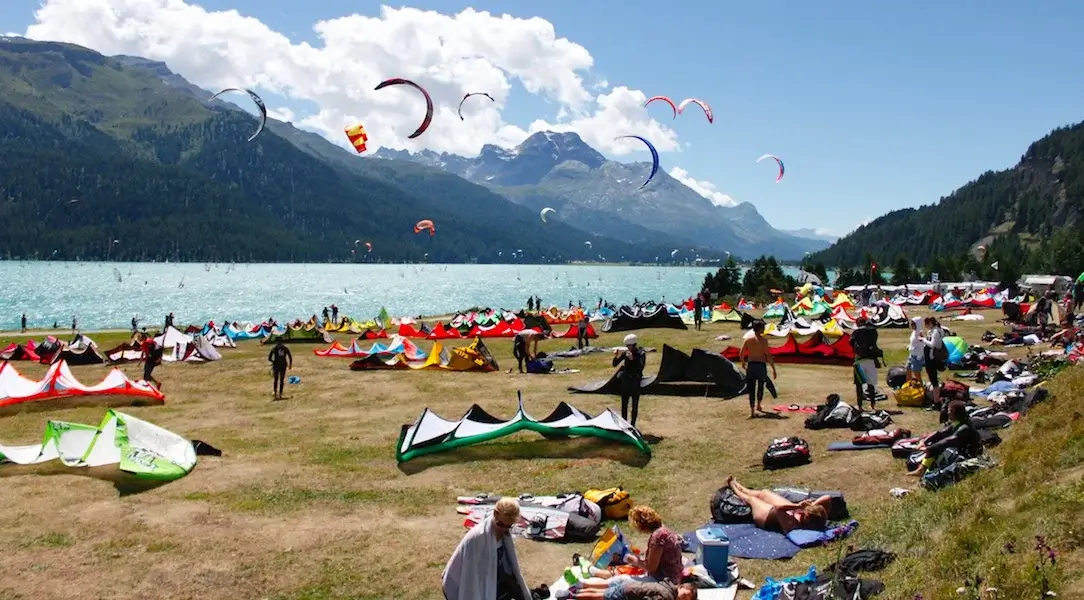
Lake Silvaplana
Nestled in the breathtaking Swiss Alps, Lake Silvaplana offers kitesurfing enthusiasts a pristine and picturesque setting to indulge in their adrenaline-fueled passion. Known as a windy paradise and alpine playground, this lake is a kiteboarding mecca that attracts thrill-seekers from around the world.
The Swiss adrenaline rush experienced on the crystal-clear waters of Lake Silvaplana is unmatched. Surrounded by stunning mountain views, kitesurfers can revel in the Silvaplana serenity while harnessing the power of the wind to propel them across the lake’s surface.
Whether you’re a beginner or a seasoned pro, Lake Silvaplana provides the ideal combination of natural beauty and thrilling kitesurfing conditions for an unforgettable experience.
Wind conditions
Lake Silvaplana, located in the Engadin Valley, is renowned for its favorable wind conditions, particularly for windsurfing and kitesurfing. While specific wind conditions can vary throughout the year, Lake Silvaplana generally experiences consistent wind patterns that make it an ideal destination for wind sports enthusiasts. Here’s a general overview of the average yearly wind conditions at Lake Silvaplana in regards to kitesurfing:
Thermal Winds:
- Lake Silvaplana benefits from reliable thermal winds, which are generated by temperature differences between the lake and surrounding landmasses.
- During the spring, summer, and early autumn months, thermal winds at Lake Silvaplana are prevalent, typically picking up in the late morning or early afternoon as the land heats up.
- These thermal winds provide consistent and predictable wind conditions for kitesurfing, with average wind speeds ranging from 15 to 25 knots.
Prevailing Wind Direction:
- The prevailing wind direction at Lake Silvaplana is from the northwest, known as the Maloja wind, which blows down the valley towards the lake.
- This northwest wind direction creates favorable conditions for kitesurfing along the length of the lake, allowing riders to enjoy long runs and ample space for maneuvers.
Seasonal Variations:
- The kitesurfing season at Lake Silvaplana typically spans from late spring to early autumn when thermal winds are most prevalent and reliable.
- The summer months, particularly June, July, and August, tend to offer the most consistent and strongest winds, making them the peak season for kitesurfing enthusiasts.
- During the winter months, wind conditions at Lake Silvaplana may be less predictable, with occasional strong winds and gusts, but kitesurfing activity is less common due to colder temperatures.
Local Variations and Considerations:
- While the northwest wind is the prevailing direction, there can be variations in wind speed and direction depending on local weather patterns and the surrounding topography.
- Kitesurfers should be aware of potential wind shadows or turbulence caused by nearby mountains and adjust their positioning accordingly for optimal riding conditions.
Overall, Lake Silvaplana offers consistent and reliable wind conditions throughout the kitesurfing season, providing enthusiasts with ample opportunities to enjoy the sport against the backdrop of stunning alpine scenery.
Water conditions
Lake Silvaplana offers favorable water conditions for kitesurfing, complementing its renowned wind conditions. Here’s an overview of the water conditions at Lake Silvaplana in regards to kitesurfing:
Water Temperature:
- The water temperature at Lake Silvaplana varies throughout the year, with warmer temperatures during the summer months and cooler temperatures during the winter.
- During the peak kitesurfing season in summer, typically from June to August, water temperatures range from around 15 to 20 degrees Celsius (59 to 68 degrees Fahrenheit), providing comfortable conditions for kitesurfing activities.
- In the winter months, water temperatures can drop significantly, requiring kitesurfers to wear appropriate wetsuits or drysuits to stay warm.
Water Depth:
- Lake Silvaplana offers varying water depths, with shallower areas near the shoreline and deeper sections further out.
- The shallow areas near the shore are suitable for launching and landing kites, making them convenient for kitesurfers.
- Kitesurfers should be mindful of underwater obstacles and rocky areas, especially in shallower sections of the lake.
Wave Conditions:
- Lake Silvaplana is not known for significant waves, as it is an inland lake. However, wind-generated chop and small waves may occur, particularly during periods of strong winds.
- The lack of large waves makes Lake Silvaplana ideal for freestyle kitesurfing and practicing tricks, as riders can focus on maneuvers without navigating large swells.
Currents and Tides:
- Lake Silvaplana does not experience significant tidal currents, as it is a freshwater lake with minimal tidal influence.
- However, kitesurfers should be aware of any local currents caused by wind patterns or inflows from nearby streams or rivers.
Safety Considerations:
- While Lake Silvaplana generally offers safe and enjoyable conditions for kitesurfing, it’s essential for riders to practice water safety and be prepared for changing weather conditions.
- Kitesurfers should wear appropriate safety gear, including a helmet, life jacket, and leash, and be familiar with emergency procedures in case of accidents or mishaps on the water.
Overall, Lake Silvaplana provides kitesurfers with a picturesque setting and favorable water conditions for enjoying the sport. Whether you’re a beginner learning the ropes or an experienced rider honing your skills, Lake Silvaplana offers ample opportunities for kitesurfing enthusiasts to experience the thrill of riding on the water against the backdrop of stunning alpine scenery.
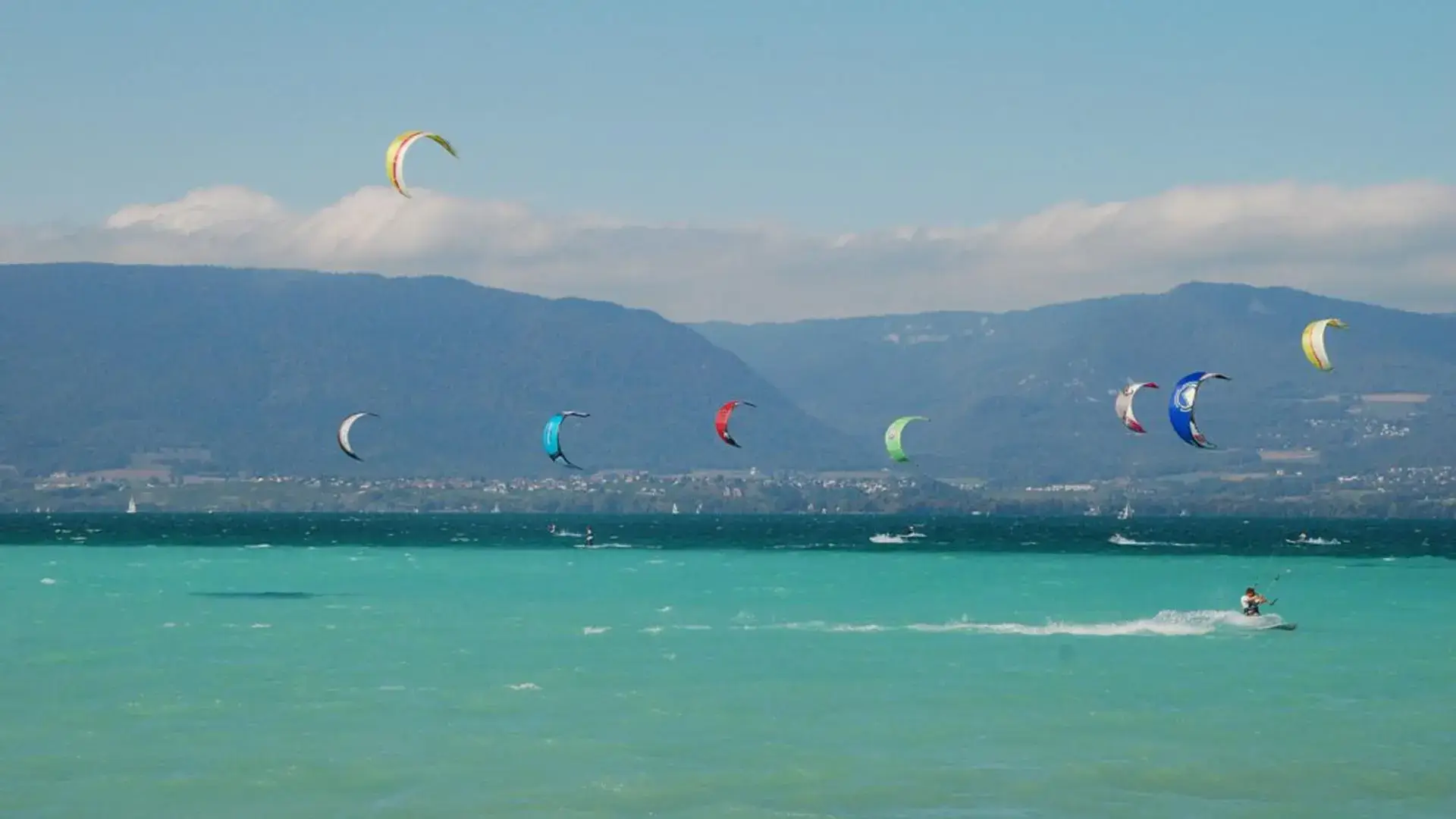
Lake Neuchâtel
Located in the French-speaking region of Switzerland, Lake Neuchâtel offers kitesurfing enthusiasts a unique blend of scenic beauty and ideal wind conditions for an exhilarating experience on the water. The lake provides a stunning backdrop for kitesurfing adventures, with the Jura Mountains in the distance and picturesque vineyards along the shoreline.
Kitesurfers can benefit from the consistent wind conditions that make Lake Neuchâtel a prime spot for this water sport. To ensure a safe and enjoyable experience, there are local kite schools available for beginners and those looking to improve their skills. Additionally, the area offers various amenities such as cafes, restaurants, and accommodations for kitesurfers to relax and unwind after a day on the water.
Wind conditions
Lake Neuchâtel offers favorable wind conditions for kitesurfing enthusiasts throughout the year. Here’s an overview of the average yearly wind conditions at Lake Neuchâtel in regards to kitesurfing:
Thermal Winds:
- Lake Neuchâtel benefits from reliable thermal winds, which are prevalent during the spring, summer, and early autumn months.
- Thermal winds occur as a result of temperature differences between the lake surface and surrounding landmasses. As the land heats up during the day, warm air rises and creates winds blowing towards the lake.
- These thermal winds provide consistent and predictable wind patterns for kitesurfing, particularly during the afternoon hours when the land has heated up sufficiently.
Prevailing Wind Direction:
- The prevailing wind direction at Lake Neuchâtel varies depending on the time of day and local weather conditions.
- In general, kitesurfers can expect winds to blow from the west or northwest during the afternoon as thermal activity peaks. However, wind direction can also be influenced by local topography and weather systems.
Wind Speed:
- Wind speeds at Lake Neuchâtel can vary throughout the year but typically range from 10 to 20 knots during peak kitesurfing season.
- During the summer months, when thermal winds are strongest, wind speeds may occasionally exceed 20 knots, providing ideal conditions for kitesurfing enthusiasts to enjoy extended sessions on the water.
Seasonal Variations:
- The kitesurfing season at Lake Neuchâtel typically spans from late spring to early autumn, coinciding with the period of strongest thermal activity and most reliable wind conditions.
- The summer months, particularly June, July, and August, tend to offer the most consistent and strongest winds, making them the peak season for kitesurfing on the lake.
Local Variations and Considerations:
- While thermal winds provide reliable conditions for kitesurfing on Lake Neuchâtel, wind strength and direction can vary depending on local geography and weather patterns.
- Kitesurfers should be aware of potential wind shadows or turbulence caused by nearby landmasses and adjust their positioning accordingly for optimal riding conditions.
Overall, Lake Neuchâtel offers favorable wind conditions for kitesurfing enthusiasts throughout the year, with reliable thermal winds providing consistent and enjoyable riding opportunities against the backdrop of scenic Swiss landscapes.
Water conditions
Lake Neuchâtel offers suitable water conditions for kitesurfing enthusiasts, complementing its favorable wind conditions. Here’s an overview of the water conditions at Lake Neuchâtel in regards to kitesurfing:
- Water Temperature:
- The water temperature at Lake Neuchâtel varies throughout the year, with warmer temperatures during the summer months and cooler temperatures during the winter.
- During the peak kitesurfing season in summer, typically from June to August, water temperatures range from around 18 to 22 degrees Celsius (64 to 72 degrees Fahrenheit), providing comfortable conditions for kitesurfing activities.
- In the winter months, water temperatures can drop significantly, requiring kitesurfers to wear appropriate wetsuits or drysuits to stay warm.
- Water Depth:
- Lake Neuchâtel offers varying water depths, with shallower areas near the shoreline and deeper sections further out.
- The shallow areas near the shore are suitable for launching and landing kites, making them convenient for kitesurfers.
- Kitesurfers should be mindful of underwater obstacles, such as rocks or sandbars, particularly in shallower sections of the lake.
- Wave Conditions:
- Lake Neuchâtel is not known for significant waves, as it is an inland lake with relatively calm waters.
- However, wind-generated chop and small waves may occur, particularly during periods of strong winds or boat traffic.
- The lack of large waves makes Lake Neuchâtel ideal for freestyle kitesurfing and practicing maneuvers, as riders can focus on tricks without navigating challenging wave conditions.
- Currents and Tides:
- Lake Neuchâtel does not experience significant tidal currents, as it is a freshwater lake with minimal tidal influence.
- However, kitesurfers should be aware of any local currents caused by wind patterns or inflows from nearby rivers or streams.
- Safety Considerations:
- While Lake Neuchâtel generally offers safe and enjoyable conditions for kitesurfing, it’s essential for riders to practice water safety and be prepared for changing weather conditions.
- Kitesurfers should wear appropriate safety gear, including a helmet, life jacket, and leash, and be familiar with emergency procedures in case of accidents or mishaps on the water.
Overall, Lake Neuchâtel provides kitesurfers with suitable water conditions for enjoying the sport against the backdrop of scenic Swiss landscapes. Whether you’re a beginner learning the basics or an experienced rider honing your skills, Lake Neuchâtel offers ample opportunities for kitesurfing enthusiasts to experience the thrill of riding on the water.
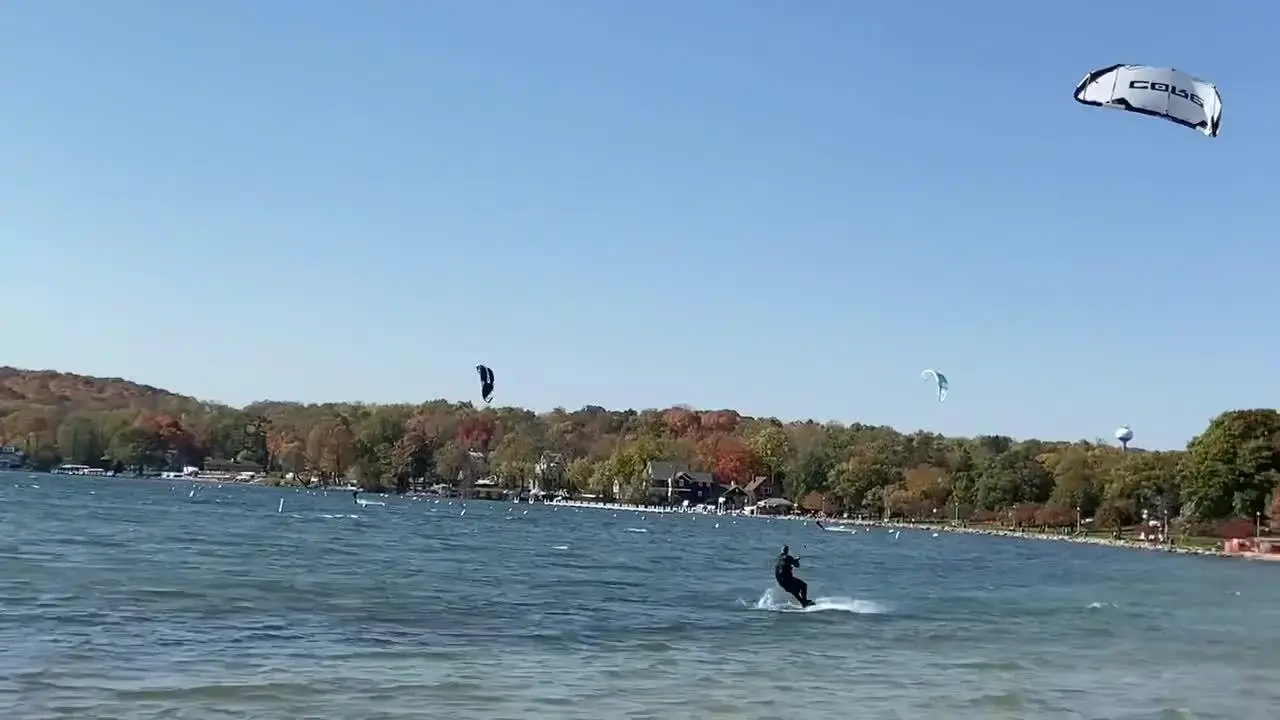
Lake Geneva (Lac Léman)
With its expansive waters and diverse shoreline, Lake Geneva, also known as Lac Léman, stands out as a prominent kitesurfing destination in Switzerland. The lake offers excellent wind conditions, especially during the summer months, attracting kitesurfers of all levels.
Riders can enjoy breathtaking scenic views of the surrounding mountains while gliding across the lake’s clear waters. The local kiteboarding community is welcoming and vibrant, providing a supportive atmosphere for enthusiasts. Nearby amenities such as cafes, restaurants, and equipment rental shops make it convenient for visitors.
The best times to visit Lake Geneva for kitesurfing are typically from May to September when the wind is most consistent, and the weather is pleasant, offering ideal conditions for an unforgettable kitesurfing experience.
Wind conditions
Lake Geneva, situated in the French-speaking part of Switzerland, offers favorable wind conditions for kitesurfing enthusiasts throughout the year. Here’s an overview of the average yearly wind conditions at Lake Geneva in regards to kitesurfing:
Thermal Winds:
- Lake Geneva benefits from reliable thermal winds, which are prevalent during the spring, summer, and early autumn months.
- Thermal winds occur as a result of temperature differences between the lake surface and surrounding landmasses. As the land heats up during the day, warm air rises and creates winds blowing towards the lake.
- These thermal winds provide consistent and predictable wind patterns for kitesurfing, particularly during the afternoon hours when the land has heated up sufficiently.
Prevailing Wind Direction:
- The prevailing wind direction at Lake Geneva varies depending on the time of day and local weather conditions.
- In general, kitesurfers can expect winds to blow from the west or northwest during the afternoon as thermal activity peaks. However, wind direction can also be influenced by local topography and weather systems.
Wind Speed:
- Wind speeds at Lake Geneva can vary throughout the year but typically range from 10 to 20 knots during peak kitesurfing season.
- During the summer months, when thermal winds are strongest, wind speeds may occasionally exceed 20 knots, providing ideal conditions for kitesurfing enthusiasts to enjoy extended sessions on the water.
Seasonal Variations:
- The kitesurfing season at Lake Geneva typically spans from late spring to early autumn, coinciding with the period of strongest thermal activity and most reliable wind conditions.
- The summer months, particularly June, July, and August, tend to offer the most consistent and strongest winds, making them the peak season for kitesurfing on the lake.
Local Variations and Considerations:
- While thermal winds provide reliable conditions for kitesurfing on Lake Geneva, wind strength and direction can vary depending on local geography and weather patterns.
- Kitesurfers should be aware of potential wind shadows or turbulence caused by nearby landmasses and adjust their positioning accordingly for optimal riding conditions.
Overall, Lake Geneva offers favorable wind conditions for kitesurfing enthusiasts throughout the year, with reliable thermal winds providing consistent and enjoyable riding opportunities against the backdrop of scenic Swiss landscapes.
Water conditions
Lake Geneva, one of the largest lakes in Europe, offers diverse water conditions for kitesurfing enthusiasts. Here’s an overview of the water conditions at Lake Geneva in regards to kitesurfing:
Water Temperature:
- The water temperature at Lake Geneva varies throughout the year, with warmer temperatures during the summer months and cooler temperatures during the winter.
- During the peak kitesurfing season in summer, typically from June to August, water temperatures range from around 18 to 22 degrees Celsius (64 to 72 degrees Fahrenheit), providing comfortable conditions for kitesurfing activities.
- In the winter months, water temperatures can drop significantly, requiring kitesurfers to wear appropriate wetsuits or drysuits to stay warm.
Water Depth:
- Lake Geneva offers varying water depths, with shallow areas near the shoreline and deeper sections further out.
- The shallow areas near the shore are suitable for launching and landing kites, making them convenient for kitesurfers.
- Kitesurfers should be mindful of underwater obstacles, such as rocks or sandbars, particularly in shallower sections of the lake.
Wave Conditions:
- Lake Geneva is not known for significant waves, as it is an inland lake with relatively calm waters.
- However, wind-generated chop and small waves may occur, particularly during periods of strong winds or boat traffic.
- The lack of large waves makes Lake Geneva ideal for freestyle kitesurfing and practicing maneuvers, as riders can focus on tricks without navigating challenging wave conditions.
Currents and Tides:
- Lake Geneva does not experience significant tidal currents, as it is a freshwater lake with minimal tidal influence.
- However, kitesurfers should be aware of any local currents caused by wind patterns or inflows from nearby rivers or streams.
Safety Considerations:
- While Lake Geneva generally offers safe and enjoyable conditions for kitesurfing, it’s essential for riders to practice water safety and be prepared for changing weather conditions.
- Kitesurfers should wear appropriate safety gear, including a helmet, life jacket, and leash, and be familiar with emergency procedures in case of accidents or mishaps on the water.
Overall, Lake Geneva provides kitesurfers with suitable water conditions for enjoying the sport against the backdrop of scenic Swiss landscapes. Whether you’re a beginner learning the basics or an experienced rider honing your skills, Lake Geneva offers ample opportunities for kitesurfing enthusiasts to experience the thrill of riding on the water.

Lake Zurich
Lake Zurich, known for its picturesque setting and favorable wind conditions, is a popular kitesurfing spot in Switzerland offering enthusiasts a unique experience on the water.
Kitesurfers flock to Lake Zurich for its excellent wind conditions, which make it ideal for both beginners and experienced riders. Local regulations ensure safety on the water, with designated areas for kitesurfing to prevent interference with other water activities.
Popular beaches along the lake’s shoreline provide convenient access points for kitesurfers to launch and land. Additionally, there are several kite schools available around Lake Zurich, offering lessons for all skill levels to improve techniques and safety practices.
The scenic views of the surrounding mountains and charming villages further enhance the kitesurfing experience on Lake Zurich.
Wind conditions
Lake Zurich, situated in the heart of Switzerland, offers favorable wind conditions for kitesurfing enthusiasts, particularly during certain times of the year. Here’s an overview of the average yearly wind conditions at Lake Zurich in regards to kitesurfing:
Thermal Winds:
- Lake Zurich benefits from reliable thermal winds, which are prevalent during the spring, summer, and early autumn months.
- Thermal winds occur as a result of temperature differences between the lake surface and surrounding landmasses. As the land heats up during the day, warm air rises and creates winds blowing towards the lake.
- These thermal winds provide consistent and predictable wind patterns for kitesurfing, particularly during the afternoon hours when the land has heated up sufficiently.
Prevailing Wind Direction:
- The prevailing wind direction at Lake Zurich varies depending on the time of day and local weather conditions.
- In general, kitesurfers can expect winds to blow from the west or northwest during the afternoon as thermal activity peaks. However, wind direction can also be influenced by local topography and weather systems.
Wind Speed:
- Wind speeds at Lake Zurich can vary throughout the year but typically range from 10 to 20 knots during peak kitesurfing season.
- During the summer months, when thermal winds are strongest, wind speeds may occasionally exceed 20 knots, providing ideal conditions for kitesurfing enthusiasts to enjoy extended sessions on the water.
Seasonal Variations:
- The kitesurfing season at Lake Zurich typically spans from late spring to early autumn, coinciding with the period of strongest thermal activity and most reliable wind conditions.
- The summer months, particularly June, July, and August, tend to offer the most consistent and strongest winds, making them the peak season for kitesurfing on the lake.
Local Variations and Considerations:
- While thermal winds provide reliable conditions for kitesurfing on Lake Zurich, wind strength and direction can vary depending on local geography and weather patterns.
- Kitesurfers should be aware of potential wind shadows or turbulence caused by nearby landmasses and adjust their positioning accordingly for optimal riding conditions.
Overall, Lake Zurich offers favorable wind conditions for kitesurfing enthusiasts throughout the year, with reliable thermal winds providing consistent and enjoyable riding opportunities against the backdrop of scenic Swiss landscapes.
Water conditions
Lake Zurich offers suitable water conditions for kitesurfing enthusiasts, complementing its favorable wind conditions. Here’s an overview of the water conditions at Lake Zurich in regards to kitesurfing:
Water Temperature:
- The water temperature at Lake Zurich varies throughout the year, with warmer temperatures during the summer months and cooler temperatures during the winter.
- During the peak kitesurfing season in summer, typically from June to August, water temperatures range from around 18 to 22 degrees Celsius (64 to 72 degrees Fahrenheit), providing comfortable conditions for kitesurfing activities.
- In the winter months, water temperatures can drop significantly, requiring kitesurfers to wear appropriate wetsuits or drysuits to stay warm.
Water Depth:
- Lake Zurich offers varying water depths, with shallow areas near the shoreline and deeper sections further out.
- The shallow areas near the shore are suitable for launching and landing kites, making them convenient for kitesurfers.
- Kitesurfers should be mindful of underwater obstacles, such as rocks or sandbars, particularly in shallower sections of the lake.
Wave Conditions:
- Lake Zurich is not known for significant waves, as it is an inland lake with relatively calm waters.
- However, wind-generated chop and small waves may occur, particularly during periods of strong winds or boat traffic.
- The lack of large waves makes Lake Zurich ideal for freestyle kitesurfing and practicing maneuvers, as riders can focus on tricks without navigating challenging wave conditions.
Currents and Tides:
- Lake Zurich does not experience significant tidal currents, as it is a freshwater lake with minimal tidal influence.
- However, kitesurfers should be aware of any local currents caused by wind patterns or inflows from nearby rivers or streams.
Safety Considerations:
- While Lake Zurich generally offers safe and enjoyable conditions for kitesurfing, it’s essential for riders to practice water safety and be prepared for changing weather conditions.
- Kitesurfers should wear appropriate safety gear, including a helmet, life jacket, and leash, and be familiar with emergency procedures in case of accidents or mishaps on the water.
Overall, Lake Zurich provides kitesurfers with suitable water conditions for enjoying the sport against the backdrop of scenic Swiss landscapes. Whether you’re a beginner learning the basics or an experienced rider honing your skills, Lake Zurich offers ample opportunities for kitesurfing enthusiasts to experience the thrill of riding on the water.
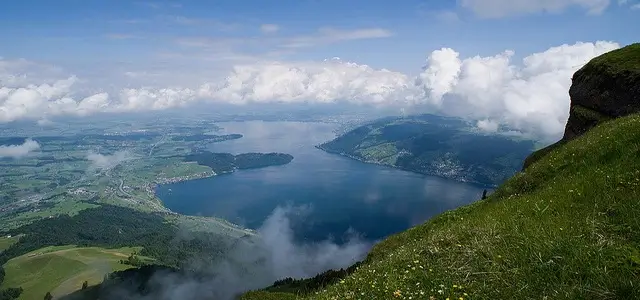
Lake Zug
Nestled amidst the stunning Swiss landscapes, Lake Zug offers kitesurfing enthusiasts a captivating blend of natural beauty and thrilling wind conditions for a truly exhilarating experience on the water.
The lake is renowned for its consistent wind patterns, making it ideal for kitesurfing throughout the season. Kite schools dotting the shoreline provide lessons for all skill levels, from beginners to advanced riders looking to perfect their technique.
Local accommodations cater to kitesurfers, offering convenient stays near the lake with easy access to the water. The picturesque views of the surrounding mountains add to the charm of Lake Zug, creating a serene backdrop for kiteboarding enthusiasts.
Additionally, the lake hosts various kiteboarding events that attract both local and international riders, adding to the vibrant kitesurfing scene in Switzerland.
Wind conditions
Lake Zug, located near the city of Zug in central Switzerland, offers favorable wind conditions for kitesurfing enthusiasts, particularly during certain times of the year. Here’s an overview of the average yearly wind conditions at Lake Zug in regards to kitesurfing:
Thermal Winds:
- Lake Zug benefits from reliable thermal winds, which are prevalent during the spring, summer, and early autumn months.
- Thermal winds occur as a result of temperature differences between the lake surface and surrounding landmasses. As the land heats up during the day, warm air rises and creates winds blowing towards the lake.
- These thermal winds provide consistent and predictable wind patterns for kitesurfing, particularly during the afternoon hours when the land has heated up sufficiently.
Prevailing Wind Direction:
- The prevailing wind direction at Lake Zug varies depending on the time of day and local weather conditions.
- In general, kitesurfers can expect winds to blow from the west or northwest during the afternoon as thermal activity peaks. However, wind direction can also be influenced by local topography and weather systems.
Wind Speed:
- Wind speeds at Lake Zug can vary throughout the year but typically range from 10 to 20 knots during peak kitesurfing season.
- During the summer months, when thermal winds are strongest, wind speeds may occasionally exceed 20 knots, providing ideal conditions for kitesurfing enthusiasts to enjoy extended sessions on the water.
Seasonal Variations:
- The kitesurfing season at Lake Zug typically spans from late spring to early autumn, coinciding with the period of strongest thermal activity and most reliable wind conditions.
- The summer months, particularly June, July, and August, tend to offer the most consistent and strongest winds, making them the peak season for kitesurfing on the lake.
Local Variations and Considerations:
- While thermal winds provide reliable conditions for kitesurfing on Lake Zug, wind strength and direction can vary depending on local geography and weather patterns.
- Kitesurfers should be aware of potential wind shadows or turbulence caused by nearby landmasses and adjust their positioning accordingly for optimal riding conditions.
Overall, Lake Zug offers favorable wind conditions for kitesurfing enthusiasts throughout the year, with reliable thermal winds providing consistent and enjoyable riding opportunities against the backdrop of scenic Swiss landscapes.
Water conditions
Lake Zug offers suitable water conditions for kitesurfing enthusiasts, complementing its favorable wind conditions. Here’s an overview of the water conditions at Lake Zug in regards to kitesurfing:
Water Temperature:
- The water temperature at Lake Zug varies throughout the year, with warmer temperatures during the summer months and cooler temperatures during the winter.
- During the peak kitesurfing season in summer, typically from June to August, water temperatures range from around 18 to 22 degrees Celsius (64 to 72 degrees Fahrenheit), providing comfortable conditions for kitesurfing activities.
- In the winter months, water temperatures can drop significantly, requiring kitesurfers to wear appropriate wetsuits or drysuits to stay warm.
Water Depth:
- Lake Zug offers varying water depths, with shallow areas near the shoreline and deeper sections further out.
- The shallow areas near the shore are suitable for launching and landing kites, making them convenient for kitesurfers.
- Kitesurfers should be mindful of underwater obstacles, such as rocks or sandbars, particularly in shallower sections of the lake.
Wave Conditions:
- Lake Zug is not known for significant waves, as it is an inland lake with relatively calm waters.
- However, wind-generated chop and small waves may occur, particularly during periods of strong winds or boat traffic.
- The lack of large waves makes Lake Zug ideal for freestyle kitesurfing and practicing maneuvers, as riders can focus on tricks without navigating challenging wave conditions.
Currents and Tides:
- Lake Zug does not experience significant tidal currents, as it is a freshwater lake with minimal tidal influence.
- However, kitesurfers should be aware of any local currents caused by wind patterns or inflows from nearby rivers or streams.
Safety Considerations:
- While Lake Zug generally offers safe and enjoyable conditions for kitesurfing, it’s essential for riders to practice water safety and be prepared for changing weather conditions.
- Kitesurfers should wear appropriate safety gear, including a helmet, life jacket, and leash, and be familiar with emergency procedures in case of accidents or mishaps on the water.
Overall, Lake Zug provides kitesurfers with suitable water conditions for enjoying the sport against the backdrop of scenic Swiss landscapes. Whether you’re a beginner learning the basics or an experienced rider honing your skills, Lake Zug offers ample opportunities for kitesurfing enthusiasts to experience the thrill of riding on the water.